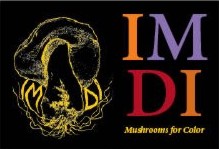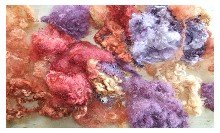Newsletter #2 from SCOTLAND 2012 by Marilyn Caddell & Trisha Gow
SPREADING THE WORD- During the past two years I have been spreading the word about the magic of fungi dyes, giving talks to various groups and exhibiting items made from fungi dyed yarn, fleece, etc. On the way back from one of these trips to the south of England we stopped to visit a friend. She had a lovely surprise for me – a huge Inonotus hispidus on one of her ash trees. As it had rained a lot in the previous weeks it contained a lot of moisture, so it took me quite a while to cut it up and dry it – but what a lot of dye potential ! I know I can re-use the same piece several times and still get a good colour – a wonderful range of golds, oranges and greens.
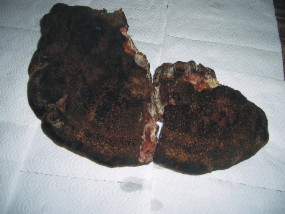 |
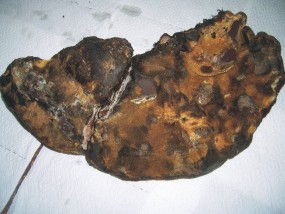 |
|---|
Last September Janette McKeown and I went over to Belfast, Northern Ireland, to lead a two day workshop for the Northern Ireland Guild of Weavers, Spinners and Dyers. Day one was taken up with dyeing hanks of yarn so that all the participants could take away a sample card and use the remaining yarn for a guild project. They were all totally amazed at the variety and vibrancy of the colours. On the second day Janette showed them how to make cobweb felt scarves from merino tops and apply dyes with syringes and foam pads. We definitely ended the weekend with many converts who will be scouring their local woods each autumn for fungi!
My greatest challenge was a workshop that I led in October at a 60 acre community wood called Pishwanton, to the east of Edinburgh. It is owned by the Life Science Trust. They run courses on environmental and ecological life style and all the animals and plants are strictly organically raised. There is no electricity, no running water and the building we worked in had a turf roof. It was beautiful inside, with big arched windows, a stone wood burning stove, lots of spinning wheels and some looms. The two ends of the building were open to the elements at the front and were used for the carpentry involved for the new buildings.
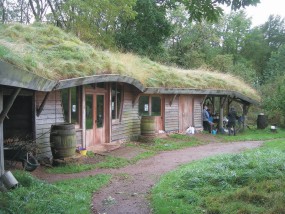 |
 |
|---|
There was only one composting loo, set apart in among the trees, so we were careful not to drink too much! NOTHING could be discarded or emptied onto the soil, so in advance of the workshop I had to gather together camping gas burners to cook up the dyes, and dozens of plastic milk bottles to take away all rinsing water and excess dye liquid. Packing everything, including all the pots and pans, into the car was a work of art. We had hoped to work outside and heat some of the dye pots over an open fire, but, of course, it rained all day, so we had to use the woodworkers quarters. It was a squash with so many pots on the go and bodies squeezed in, but we had a lot of fun, and everyone went home happy with their sample cards and brightly coloured skeins.
 |
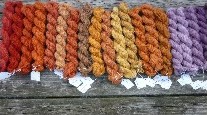 |
|---|
Now I am looking forward to the next Fungi and Fibre Symposium in Spain in October, meeting up with ‘old' friends, learning new skills and exploring a new part of the world. See you there! ~ Marilyn Caddell
In October 2011, I was invited to give a talk & do a sample workshop for the Berkshire Guild of Weaving Spinning & Dyeing. Carole Thorpe and Irene Taydler came along to help and we produced this selection of small samples using Innonotus Hispidus, Hapilopilus nidulans and C. semi-sanguineus. Some very enthusiastic people were also able to take home the residue dye for their own use!
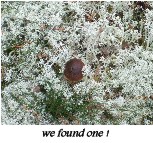 |
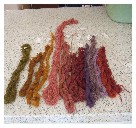 |
|---|
Carole and I then joined Monika Brown at her home in Sweden for a few days mushrooming. Unfortunately for us there were not many mushrooms left but we had lots of fun. We are hoping to go back sometime- it is just so good to be able to find dye fungi in abundance - we do struggle to find them in the UK. ~ Trisha Gow
__________________________________________________________
Newsletter #1 from
Scotland by Trisha Gow - 2011
Marilyn Caddell and I went on a foray on our return from Sweden to Glen
Tress near Peebles. This area has been extensively developed for cycling
and has rough tracks all over the woods. As a result many of the areas
we found dye fungi have gone. We found a few C.
semi sanquineus but
went back to the tree line, where no-one now goes, to find some Phaeolus
schweinitzii and Paxillus atrotomentosus .
I also found Phaeolus in my local woods – a good year for it I think.
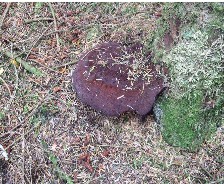 |
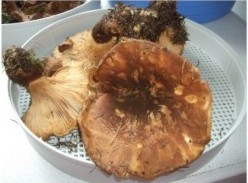 |
|---|
This autumn Marilyn and Jeanette are planning a visit to Belfast in Northern Ireland to run a fungi dye workshop. Trisha Gow and Carole Thorpe are going to do a fungi dye demonstration for the Berkshire Guild of Weavers Spinners and Dyers (near Oxford, England)
|
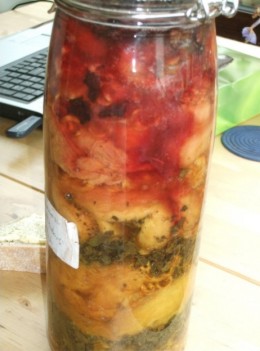 |
|---|
